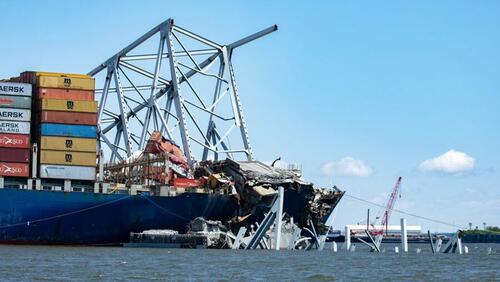Container Ship Lacked Backup System To Avoid Baltimore Bridge Strike
By John Gallagher of FreightWaves
Cargo vessels are not equipped with backup power sufficient to avoid situations such as the one in March when the container ship Dali struck and collapsed Baltimore’s Francis Scott Key Bridge, the country’s top transportation safety investigator told lawmakers.
Testifying before the House Transportation and Infrastructure Committee on Wednesday, National Transportation Safety Board Chair Jennfier Homendy said the backup generator that kicked in after the Dali lost power roughly half a mile from the bridge restored emergency lighting, navigation functions, radio equipment, alarms and a steering pump that allowed for low-speed, limited rudder movements.
That wasn’t enough.
“It does not power propulsion, and without the propeller turning, the rudder was less effective — they were essentially drifting,” she told the committee.
“If you wanted to regain propulsion through any sort of emergency generator, it would literally take a six-storey generator on a vessel to do that. There is that redundancy in, say, cruise ships, but the Dali is not unlike other [cargo] vessels.”
Homendy’s testimony came a day after NTSB released a preliminary report on the March 26 accident that killed six bridge construction workers.
The report shows that the Dali experienced four total power outages — including two that occurred the day before the accident during routine maintenance being performed by the vessel’s crew while the ship was docked at the Port of Baltimore.
While recovering from the second power outage, the crews switched to a different transformer and set of circuit breakers from those that had been in use for several months. “Switching breakers is not unusual but may have affected operations the very next day on the accident voyage,” Homendy said at the hearing.
“We will continue evaluating the design and operation of the Dali’s power distribution system, including its breakers. Examination of damage to the vessel will continue when the ship is cleared of debris and moved to a shoreside facility.”
Timelines and costs
The U.S. Coast Guard and U.S. Army Corps of Engineers have been able to reopen much of the channel since the accident, officials from those agencies testified at the hearing, adding that they expect the vessel to be refloated and removed from the channel as early as next week.
Shailen Bhatt, administrator of the Federal Highway Administration, confirmed to lawmakers a preliminary estimate to replace the bridge at $1.7 billion to $1.9 billion. It will take four years to construct, with completion estimated to come sometime in 2028, he said.
Bhatt was questioned by several lawmakers on the administration’s request to have 100% of the bridge’s replacement cost paid upfront through federal funds, which will require legislation approved by Congress.
He pointed out that getting the money approved upfront by Congress “removes an element of uncertainty” to insure against construction delays. In addition, a significant amount of that funding will be paid back to the government eventually through insurance payment recovery and money received through litigation proceedings from responsible parties, he said.
“But we don’t want to wait for all the litigation and NTSB investigations and insurance issues” to be resolved, he said.
Rerouting delays increase
During the hearing, Congresswoman Eleanor Holmes Norton, Washington’s nonvoting delegate in the House, sought comment from Bhatt on federal data showing that traffic crashes rose 29% on alternative routes in the weeks following the Key Bridge collapse.
“The same data show that it now takes between two and four times longer for drivers to travel those alternative routes,” she said. “That traffic means trucks are delayed in reaching their destinations, commuters are late getting to their jobs or home to their families, and there is more air pollution and wasted fuel.”
Bhatt noted that when significant highway capacity is lost, traffic adjusts and levels out. However, “that’s not happening in Baltimore to the same extent, and I think it’s because of just the criticality of this artery,” he said.
“It’s important for Maryland and Baltimore, but it’s also important for the Northeast Corridor. So yes there are trucks and vehicles moving through neighborhoods that normally they would not, and that’s why it’s important that we move with as much speed as possible” to rebuild the bridge.
Bhatt told lawmakers he would look into potential long-term relief, including hours-of-service waivers, for truck drivers affected by the delays.
Bridge assessments recommended
As part of its investigation, NTSB is looking at other areas in the U.S. where bridges have been improved following vessel strikes. Depending on the information collected, the agency could issue an urgent safety recommendation even before a final report is issued in the Dali accident, which could take up to 18 months.
“The key is, you have here a bridge that was opened in 1977. It’s not the bridge that’s getting larger, it’s not the waterway that’s getting larger, it’s the vessels that are getting larger — both width and height. So it’s important that states and other bridge owners look at, from a risk assessment standpoint, what type of vessel traffic is going through, and how is the bridge protected.”
Tyler Durden
Thu, 05/16/2024 – 20:35

